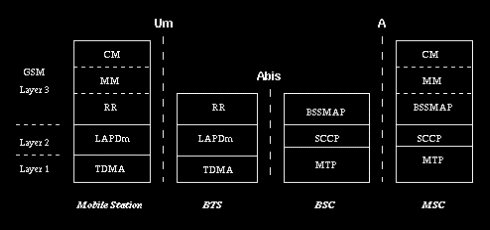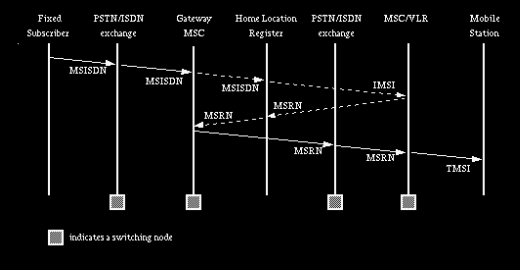|
Network Aspects |
Ensuring the transmission of voice or data of a given quality over the radio link is only part of the function of a cellular mobile network. A GSM mobile can seamlessly roam nationally and internationally, which requires that registration, authentication, call routing and location updating functions exist and are standardized in GSM networks. In addition, the fact that the geographical area covered by the network is divided into cells necessitates the implementation of a handover mechanism. These functions are performed by the Network Subsystem, mainly using the Mobile Application Part (MAP) built on top of the Signalling System No. 7 protocol.

The signalling protocol in GSM is structured into three general layers , depending on the interface, as shown in Figure 3. Layer 1 is the physical layer, which uses the channel structures discussed above over the air interface. Layer 2 is the data link layer. Across the Um interface, the data link layer is a modified version of the LAPD protocol used in ISDN, called LAPDm. Across the A interface, the Message Transfer Part layer 2 of Signalling System Number 7 is used. Layer 3 of the GSM signalling protocol is itself divided into 3 sublayers.
An RR-session is always initiated by a mobile station through the access procedure, either for an outgoing call, or in response to a paging message. The details of the access and paging procedures, such as when a dedicated channel is actually assigned to the mobile, and the paging sub-channel structure, are handled in the RR layer. In addition, it handles the management of radio features such as power control, discontinuous transmission and reception, and timing advance.
There are four different types of handover in the GSM system, which involve transferring a call between:
Handovers can be initiated by either the mobile or the MSC (as a means of traffic load balancing). During its idle time slots, the mobile scans the Broadcast Control Channel of up to 16 neighboring cells, and forms a list of the six best candidates for possible handover, based on the received signal strength. This information is passed to the BSC and MSC, at least once per second, and is used by the handover algorithm.
The algorithm for when a handover decision should be taken is not specified in the GSM recommendations. There are two basic algorithms used, both closely tied in with power control. This is because the BSC usually does not know whether the poor signal quality is due to multipath fading or to the mobile having moved to another cell. This is especially true in small urban cells.
The 'minimum acceptable performance' algorithm gives precedence to power control over handover, so that when the signal degrades beyond a certain point, the power level of the mobile is increased. If further power increases do not improve the signal, then a handover is considered. This is the simpler and more common method, but it creates 'smeared' cell boundaries when a mobile transmitting at peak power goes some distance beyond its original cell boundaries into another cell.
The 'power budget' method uses handover to try to maintain or improve a certain level of signal quality at the same or lower power level. It thus gives precedence to handover over power control. It avoids the 'smeared' cell boundary problem and reduces co-channel interference, but it is quite complicated.
The location updating procedures, and subsequent call routing, use the MSC and two location registers: the Home Location Register (HLR) and the Visitor Location Register (VLR). When a mobile station is switched on in a new location area, or it moves to a new location area or different operator's PLMN, it must register with the network to indicate its current location. In the normal case, a location update message is sent to the new MSC/VLR, which records the location area information, and then sends the location information to the subscriber's HLR. The information sent to the HLR is normally the SS7 address of the new VLR, although it may be a routing number. The reason a routing number is not normally assigned, even though it would reduce signalling, is that there is only a limited number of routing numbers available in the new MSC/VLR and they are allocated on demand for incoming calls. If the subscriber is entitled to service, the HLR sends a subset of the subscriber information, needed for call control, to the new MSC/VLR, and sends a message to the old MSC/VLR to cancel the old registration.
For reliability reasons, GSM also has a periodic location updating procedure. If an HLR or MSC/VLR fails, to have each mobile register simultaneously to bring the database up to date would cause overloading. Therefore, the database is updated as location updating events occur. The enabling of periodic updating, and the time period between periodic updates, is controlled by the operator, and is a trade-off between signalling traffic and speed of recovery. If a mobile does not register after the updating time period, it is deregistered.
A procedure related to location updating is the IMSI attach and detach. A detach lets the network know that the mobile station is unreachable, and avoids having to needlessly allocate channels and send paging messages. An attach is similar to a location update, and informs the system that the mobile is reachable again. The activation of IMSI attach/detach is up to the operator on an individual cell basis.
The same initial random number and subscriber key are also used to compute the ciphering key using an algorithm called A8. This ciphering key, together with the TDMA frame number, use the A5 algorithm to create a 114 bit sequence that is XORed with the 114 bits of a burst (the two 57 bit blocks). Enciphering is an option for the fairly paranoid, since the signal is already coded, interleaved, and transmitted in a TDMA manner, thus providing protection from all but the most persistent and dedicated eavesdroppers.
Another level of security is performed on the mobile equipment itself, as opposed to the mobile subscriber. As mentioned earlier, each GSM terminal is identified by a unique International Mobile Equipment Identity (IMEI) number. A list of IMEIs in the network is stored in the Equipment Identity Register (EIR). The status returned in response to an IMEI query to the EIR is one of the following:
An incoming mobile terminating call is directed to the Gateway MSC (GMSC) function. The GMSC is basically a switch which is able to interrogate the subscriber's HLR to obtain routing information, and thus contains a table linking MSISDNs to their corresponding HLR. A simplification is to have a GSMC handle one specific PLMN. It should be noted that the GMSC function is distinct from the MSC function, but is usually implemented in an MSC.
The routing information that is returned to the GMSC is the Mobile Station Roaming Number (MSRN), which is also defined by the E.164 numbering plan. MSRNs are related to the geographical numbering plan, and not assigned to subscribers, nor are they visible to subscribers.
The most general routing procedure begins with the GMSC querying the called subscriber's HLR for an MSRN. The HLR typically stores only the SS7 address of the subscriber's current VLR, and does not have the MSRN (see the location updating section). The HLR must therefore query the subscriber's current VLR, which will temporarily allocate an MSRN from its pool for the call. This MSRN is returned to the HLR and back to the GMSC, which can then route the call to the new MSC. At the new MSC, the IMSI corresponding to the MSRN is looked up, and the mobile is paged in its current location area (see Figure 4).

| Send comments to webmaster Copyright © 1997 Derek Mc Donnell. All Rights Reserved. Last updated 07-Apr-1998. |
 |